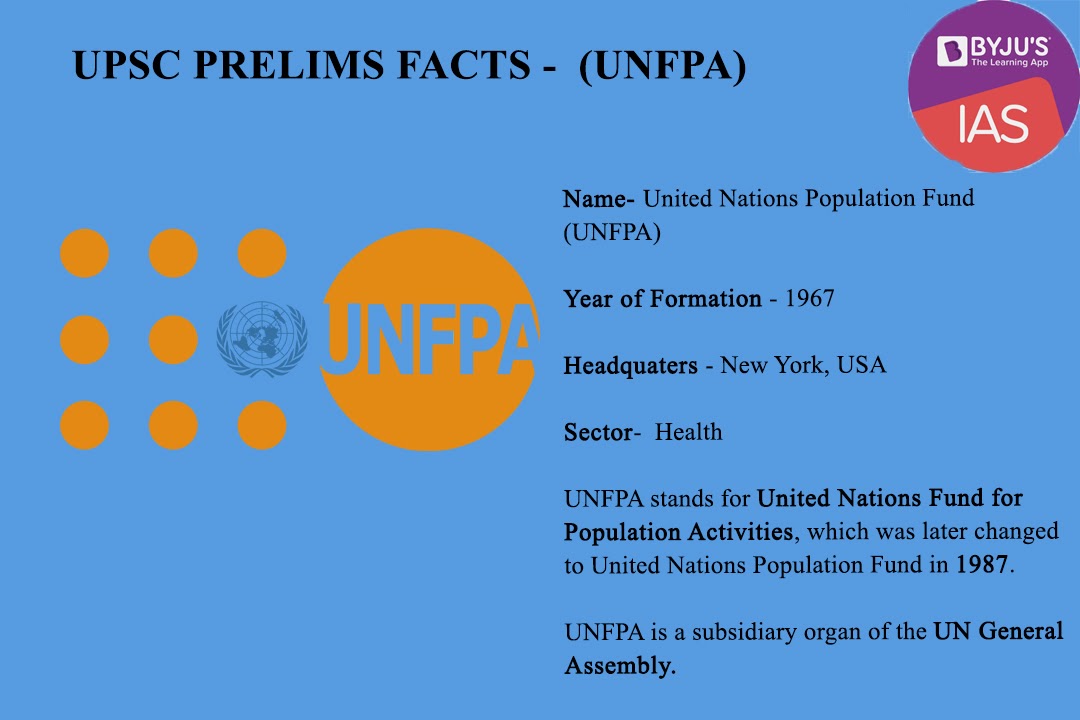The United Nations Population Fund (UNFPA) is an important programme under the United Nations. Such international bodies and programmes are very relevant for the IAS exam. In this article, you can read all about the UNFPA, its functioning, mandate, objectives and India’s relations with it.
International organisations and groupings are an important part of the International Relations section of the General Studies paper-2 in the UPSC Syllabus. International relations is a very dynamic part and is crucial for multiple papers in Prelims and Mains. Students preparing for UPSC 2021 and other Government Exams must be aware of the topic.
UNFPA UPSC Notes:- Download PDF Here

United Nations Population Fund (UNFPA)
Established in 1967 as a trust fund, UNFPA is the United Nations sexual and reproductive health agency. It became operational in the year 1969. UNFPA works as a subsidiary organ under the umbrella of the UN General Assembly which is one of the Principal Organs of the United Nations.
- The term UNFPA stands for United Nations Fund for Population Activities. It was later renamed in 1987 to the United Nations Population Fund while retaining the UNFPA abbreviation.
- The funds for UNFPA are completely supported by voluntary contributions. They include donor governments, various foundations and individuals, and intergovernmental organisations.
- The funds are not associated with the United Nations regular budget.
Aspirants would find the article very helpful in preparation for UPSC examination.
| Candidates can enhance their UPSC exam preparation by attempting UPSC Previous Years Question Papers now!!
To complement your preparation for the upcoming exam, check the following links: |
UNFPA Mission & Mandate
Mission: To deliver a world where every pregnancy is wanted, every childbirth is safe and every young person’s potential is fulfilled.
Mandate: UNFPA has the mandate to boost awareness on population issues and to support strategies to address these. It also works to develop context-specific knowledge and capacity on population and reproductive health issues.
- The mandate of UNFPA is established by the United Nations Economic and Social Council (ECOSOC).
- UNFPA works directly to tackle Sustainable Development Goal 3 on health, Goal 4 on education and Goal 5 on gender equality.
United Nations Population Fund (UNFPA) and India
According to the UNFPA reports, India will be the most populous country by the year 2028, although its fertility rate has declined from about 3.6 to 2.4 children in the last three decades.
Now a middle-income country, India has seen significant improvements in health and education but wide inequalities persist.
- Maternal mortality and gender discrimination remain high.
- Early marriage and pregnancy contribute to excessive maternal death among women under 24.
- The low status of women is a factor as well, one that is reflected in an extremely skewed ratio of girls to boys.
To get a list of other international organisations and their reports published, click on the linked article.
Programmes conducted in India by UNFPA
| Integrated sexual and reproductive health services |
|
| Adolescents and youth |
|
| Gender equality |
|
| Organizational effectiveness |
|
| Analysis on population dynamics |
|
UNFPA Report 2019 India
The year 2019 marks two important milestones in the field of reproductive health and rights: 50 years since UNFPA began operations, and 25 years since the landmark International Conference on Population and Development (ICPD) in Cairo.
The report shows that while much has been gained, much remains to be done to empower those who are not yet able to enjoy their rights and whose choices are still constrained. The pursuit of rights and choices for all is ongoing, with new challenges emerging all the time.
Read more about the United Nations at the linked article.
| UNFPA Report 2019 India Important Findings | |
| Population | India’s population stands at 1.36 Billion in 2019.
India will be the most populous country by the year 2028. |
| Growth Rate | India’s growth rate was 1.2% per year between 2010 and 2019 |
| Age Composition |
|
| Life Expectancy | Lower than the world’s (69 years) (World’s – 72) |
| Healthcare | India scores higher than the global average in terms of access to healthcare during childbirth. |
| MMR | India’s maternal mortality ratio (MMR) in 2015 was 174 deaths per lakh live births (down from 448 in 1994). |
| Fertility Rate | 2.3 births per woman, compared to 2.5 worldwide |
| Adolescent Birth Rate | India has a much lower Adolescent Birth Rate than the global rate. |
Candidates should go through the relevant links provided below to do preparation for UPSC exam even better-
Get the list of International Organizations and their Headquarters on the given link.

Comments